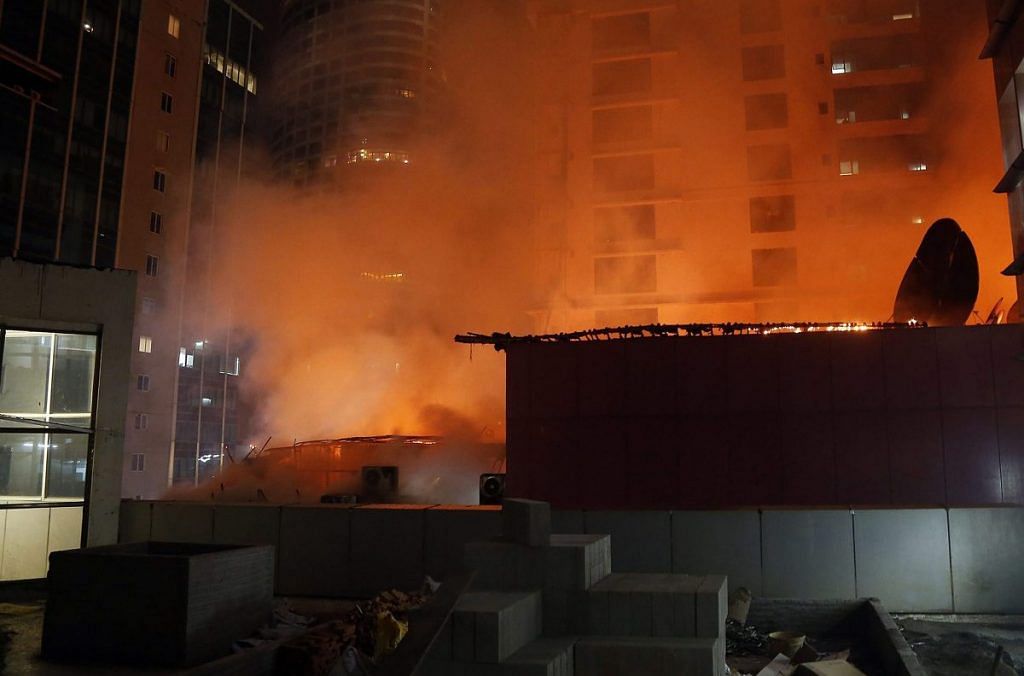Fourteen people, including a woman who was celebrating her birthday, died, and 19 others suffered injuries when a fire broke out at ‘1 Above’.
Mumbai: In the 1960s, a number of Mumbai’s textile mills mysteriously caught fire in the middle of the night, often raising eyebrows on whether the fires were meant to hasten the unlocking of these large swatches of land for commercial purposes. Over the next few decades, acres of mill lands steadily gave way to swanky malls, upper-crust restaurants, offices and plush residences. And with the blaze at a roof-top pub in Kamala Mills in the early hours of Friday, the controversial metamorphosis of Mumbai’s mill district came full circle.
Fourteen people, including a woman who was celebrating her birthday died, and 19 others suffered injuries when a fire broke out at ‘1 Above’, on the third floor of Kamala Mills’ ‘Trade House’ building. It took six hours to douse the fire.
While the Brihanmumbai Municipal Corporation’s (BMC) fire department is yet to ascertain the cause of the fire, officials said it was visible that the restaurant—with a bamboo roof and combustible material lying around—was not fire compliant. BMC officials said inadequate access to the pub also caused the casualties to increase.
Municipal Commissioner Ajoy Mehta suspended five civic body officials for the incident, and the BMC also transferred the ward officer. Chief Minister Devendra Fadnavis ordered a safety audit of all such structures, with instructions to demolish those found to be illegal.
Old structures, new problems
The erstwhile mill lands of Mumbai are now dense areas with commercial establishments and offices. The access ways of many of these restaurants are limited. Also, a number of them operate from within the old mill structures, having made interior alterations as per their requirements.
However, BMC’s deputy chief fire officer Hemant Parab said: “In the case of ‘1 Above’, access was not as much of an issue. They didn’t take basic fire compliance measures. There was a bamboo-frame roof. The problem with these establishments is also that the original structures are of mills and they have made a number of internal alterations.”
Neera Adarkar, architect and co-author of a book on the hundred-year history of Mumbai’s textile mill workers, put the transformation into the context of fire safety. “In the olden days, mills were spaces with large spans and a piping system to cater to the extreme heat of the work. There was one activity in a large area. Now, within the same façade, there are several small activities, and having strict compliance of norms and enforcing them firmly is very important,” she said.
Earlier, every piece of mill land had a water body, which helped provide immediate relief in case of such disasters. “Where are the water bodies now?” she asked.
The case of Kamala Mills
In the Kamala Mills complex itself, the BMC has given licences to 36 bars and restaurants, as per information from the civic body’s G South ward office. The neighbouring Raghuvanshi Mills has approximately another 10 licences for eateries and pubs, while Phoenix Mills has about 20 more.
“The entire mill lands story is one where authorities have consistently turned a blind eye for the benefit of a few, starting from the mill land-sharing formula, the change of land use, opening of a number of commercial establishments and so on,” Adarkar said.
“One does not know if these establishments take the necessary permissions and comply with norms, and even if they do, we don’t know if authorities give the approvals and no-objections with open eyes and necessary scrutiny.”
Strict enforcement needed
As per norms, commercial establishments are supposed to get a fire compliance certificate every six months – in January and July.
Pankaj Joshi, executive director at the Mumbai-based Urban Design Research Institute (UDRI) pointed to this as the crux of the problem.
“The density and the number of licences is not an issue here. There are dense areas with a number of packed restaurants and offices in other cities too, and there is nothing wrong with that. But one must ensure that the licences are renewed every year, and there is a strict inspection every time. In this case, I don’t think they did that,” he said.
A senior fire department official, requesting anonymity, added that in practice, the fire department’s role had steadily become limited to making recommendations, while the NoCs were actually given by ward-level Medical Officers of Health.
On planning establishments inside old existing structures, Joshi said the authorities must ensure these plans conformed to the current national building code.
“In this situation, there is definitely a problem of refuge areas, evacuation plan, and the material used. The learning is very important: that licences have to be renewed every year, and no one can shirk responsibility.”
